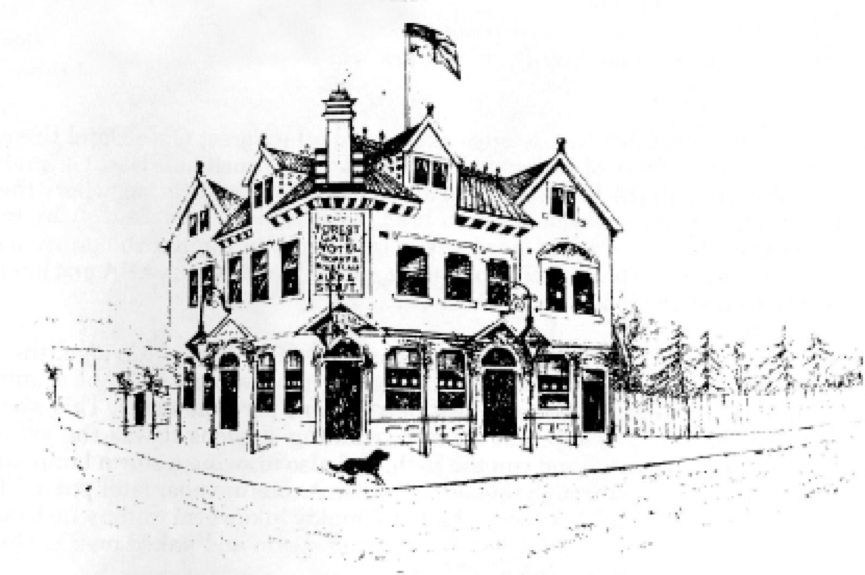 |
| Forest Gate Hotel |
Almost immediately they found an ideal home at the newly built Forest Gate Hotel in Godwin Road, Forest Gate, barely a short jog from the Wanstead Flats which remained as a welcome place of recreation for the people of the rapidly expanding East End. The new headquarters became the starting point for weekly runs and races held every Saturday throughout the winter, and it was not long before the Harriers made the Forest Gate Hotel the focal point for their Tuesday evening runs as well. The Forest Gate Hotel remained as the Beagles' winter quarters for much of the period up to the First World War, although the club used the nearby 'Holly Tree' in Danes Road for a few years at the start of the century.
During the period between the wars suburban London expanded rapidly and the club made frequent changes of headquarters in search of better country. The first winter quarters after the First War were the Green Man at Leytonstone, and the club also set up a Barking section with the HQ at the Red Lion in North Street, which the proprietor, Mr Hill, had placed at the club's disposal free of charge. The Red Lion gave access to plenty of good country including Barking Park which in those days took in ploughed fields.
For four winters from 1923 the Beagles again made the Forest Gate Hotel their base before moving to the Duke of Edinburgh on the edge of Wanstead Flats. For midweek runs the club settled at the Railway Hotel opposite Forest Gate station, where the club erected a boxing ring at the cost of £3.5s. in 1922. Many athletes would spar a few rounds after their evening runs; if there were any disturbances in the bar the guilty parties were asked to settle it in the ring. The possibility of affiliating to the ABA and holding a boxing tournament was considered during 1922.
Changing and bathing facilities were very basic. In 1923 Fred Bostridge, the Hon. Secretary, pointed out to the committee "that a great improvement could be attained in the bathing arrangements by the purchase of a suitable portable bath". This was duly agreed. While the runners were out on their training sessions it was the job of the "trainers" to warm the water and run the bath, and also to swing a storm lamp to show
the runners the way home through the settling dusk. As one member later put it: "Those lamps also did service to light up the tin baths of muddy lukewarm water which nobody seemed to mind very much - in fact with the rising steam and naked men in the half light it looked a bit like Dante's Inferno!".
By 1930, the club found that they were being hemmed in by houses and roads which made their access to cross country very difficult. This compelled a fresh move, this time to the Riggs Retreat at Brook Road, Buckhurst Hill. A variety of short lived venues were also used for mid-week runs, such as the United Services Club at Barking, the Forest Glen at Danes Road, Forest Gate, and the Aldersbrook Baptist Church.
 |
| Chigwell Row - official opening |
It was in 1938, towards the end of this restless period, that one of the committee, Phil Everard, put forward the idea that the Beagles should one day be owners-of their own HQ - an idea that many felt was an impossible dream. Fund raising started but the war intervened and the plan had to be shelved until 1947, when the building fund was re-established. Through the efforts of many members the fund gradually grew, until in 1956 enough money had been raised to make the dream a reality. But the Beagles were by no means at the end of the road, for there were considerable difficulties in acquiring a site and in obtaining approval for the plans.
The Beagles had used the Retreat at Chigwell Row ls their winter quarters since 1943 (although they did return to the Riggs Retreat for a few years in the late 1940's), and it was here that the new clubhouse was to be erected. The various obstacles were overcome during late 1957 and from July 1958 club members, under the skilful direction of architect Harry Gibbard, put their backs into the digging, cementing and bricklaying needed to make the site ready for the-erection of the two pre-fabricated buildings, taken down from a site at Loughton, which formed the new clubhouse. A grant from the Playing Fields Association provided the funding for the finishing touches.
The Chigwell Row premises were formally opened by Chris Chataway on 26 September 1959 with "an excellent concise speech which really suited the occasion".
Your given information really impressed me. It definitely has good things to learn. This content is impactful and informative.
ReplyDeletePersonal Trainer London
Personal trainer
Personal Trainer Near Me
personal trainer richmond
personal trainer kingston
personal trainer guildford
Personal trainer East London
Personal trainer west London